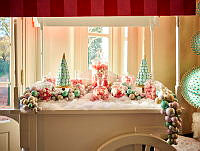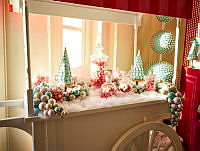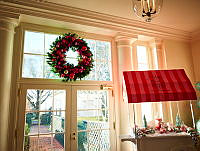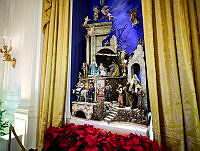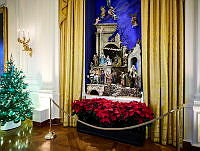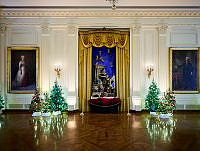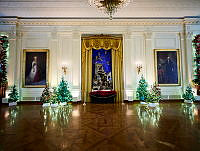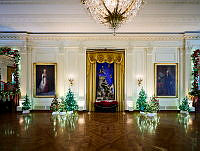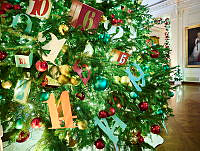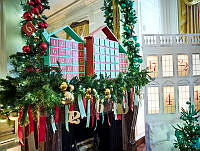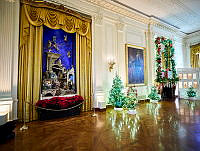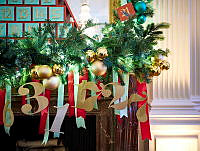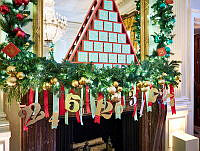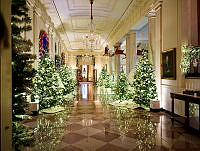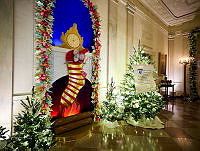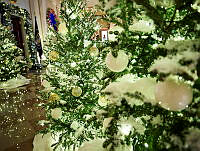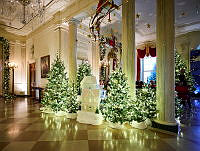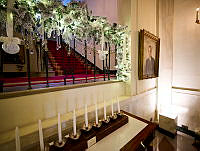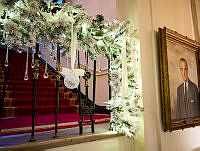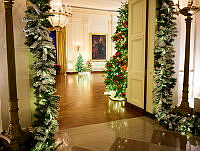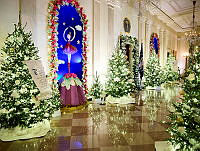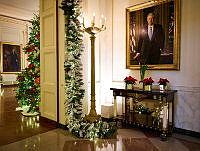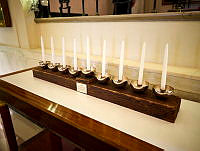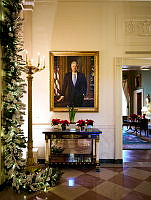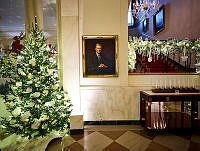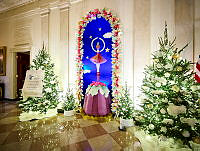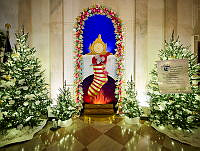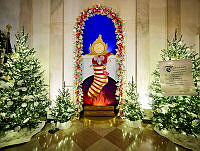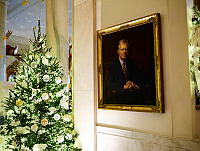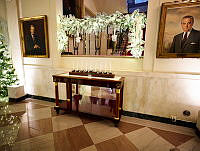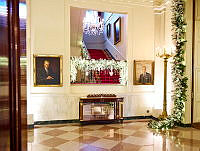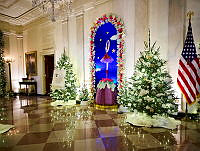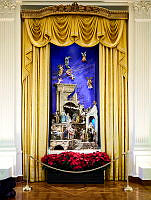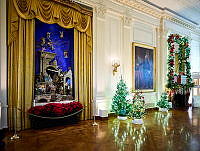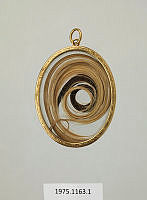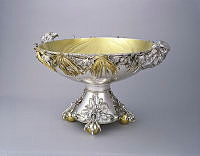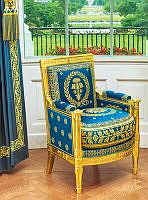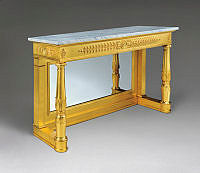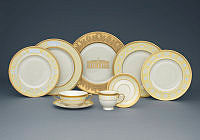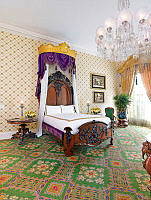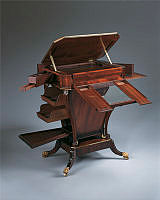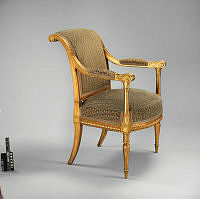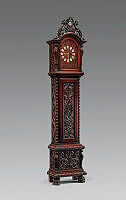A Small Slice of Kennedy Decor: The Queens’ Sitting Room
Copyright © White House Historical Association. All rights reserved under international copyright conventions. No part of this article may be reproduced or utilized in any form or by any means, electronic or mechanical, including photocopying, recording, or by any information storage and retrieval system, without permission in writing from the publisher. Requests for reprint permissions should be addressed to books@whha.org
Although the legacy of Jacqueline Kennedy’s interior decoration at the White House is fixed in Americans’ minds, there seems to be a general impression that the rooms, both public and private, have not been changed during the 40 years since her time here. Certainly much of the private quarters have been adjusted to suit the individual tastes of the succeeding first families. Even the public rooms, with a formal museum character, fostered in accordance with Mrs. Kennedy’s initiative, have been altered as the collection of fine and decorative arts has grown and revised historical insights have influenced decisions on color and design. There is, however, one “time capsule” room that retains most of its Kennedy decor. That is the Queens’ Sitting Room, something of an amalgam of the public and private, located on the northeast corner of the Second Floor in the private quarters but part of one of two formal guest suites, the other the Lincoln Bedroom.
This relatively small northeast corner room, seemingly little used in the early years of the White House, was from at least the late 1840s until 1902 part of the presidential office suite at the east end of the second floor, a room usually occupied by clerks or secretaries. When the offices were moved to the newly constructed West Wing in 1902, this room became a bedroom, reduced in size by the addition of a bathroom at the south end. After the Truman renovation of the White House, 1948-52, the room was refurnished as a sitting and dressing room for the adjoining large guest room then known as the Rose Bedroom, now the Queens’ Bedroom.
When Mrs. Kennedy arrived in 1961, only nine years had passed since the Truman rebuilding and redecorating of the interior of the house. This room, with walls painted pale blue-green, retained its floral chintz draperies, the same fabric having been used to cover two easy chairs, a dressing table in the northeast corner, and a frameless single bed serving as a daybed along the west wall. Flanking the bed was a pair of mahogany bowfront chests of drawers, part of a large purchase of household furniture adapted from antique styles. One older object joining this Truman renovation furniture was an oval mahogany cheval glass, part of a suite acquired in 1909 from the Boston manufacturer A. H. Davenport to furnish the bedroom of President William Howard Taft and First Lady Helen Herron Taft. Like the other small corner rooms, the layout of furniture was seriously influenced by the doorway, fireplace, and two large windows that occupy so much of the wall space.

A recent photograph of the Queens' Sitting Room. A Chinese tea box lined with White House wallpaper used by President Madison rests on the tea table that Mrs. Kennedy left for the room.
White House Historical AssociationIn redecorating what was called variously the Queens’ Dressing or Queens’ Sitting Room in 1962-63, Mrs. Kennedy retained much of the layout and some of the furnishings, but she gave the room a bold look, focused on a strong blue-and-white Empire-style fabric and black-and-gold furniture. The influential Paris design firm, Maison Jansen, whose president, Stéphane Boudin, was Mrs. Kennedy’s principal adviser for the White House refurbishing, supplied the brilliant blue, almost cameo-like, cotton fabric printed with white neoclassical motifs—alternating rows of swan-centered circular medallions and flower garland devices. After considering it for the draperies and upholsteries, Mrs. Kennedy selected it to cover the walls as well.1 Its jewel-like design has remained brilliant. Still in place within the two window reveals are the Jansen-designed draperies and lambrequin-edge valance boards, trimmed in a narrow white fringe made by the American firm, Scalamandre Silks, of New York. The two Truman chairs and a 19th-century daybed supplied by Jansen also retain their 1962 upholstery in this amazingly durable fabric.2
The low-post daybed, painted black with polychrome floral decoration, was flanked by two small black- finished Victorian tables acquired for the White House in the late 19th century, one inlaid with a mother-of-pearl checkerboard. Acquired in 1962 was a pair of mid-19th century “fancy chairs,” black with caned backs and seats, placed at the north end of the room, and a black papier-mâché pedestal table that was placed between the easy chairs before the east window. An ebonized Eastlake-style side chair, donated by a White House doorman, was added in 1963. A European tripod tea table, decorated in imitation of Chinese lacquerware, belonged to Mrs. Kennedy but was left for the White House on her departure in 1963.
To augment these additions, two pieces of mahogany furniture found in the room were lacquered in black with gilt trim. One of the pair of bedside chests, only 10 years old, was refinished and placed on the south wall, but even the much older Taft cheval glass was not immune to such serious decorative change when it was finished to match and left in place in the northwest corner.

The Rose Bedroom as it appeared in June 1960, having been completed in 1952 for President Harry Truman. The large guest room, now known as the Queens' Bedroom, adjoins the Queens' Sitting Room.
White House Historical AssociationArchitectural changes were made only in the southeast corner where, during the Truman renovation, the fireplace had been set on the diagonal. A simple rectangular built-in overmantel mirror, flanking sconces set amid columns of plaster stars, the surmounting ornamental plaster medallion, and the mantel itself were removed. The rather undistinguished gray marble mantel was replaced by a more stylish Truman renovation acquisition—a neoclassical white marble mantel with stop-fluted engaged columns and a wreath-carved frieze—that had been removed from the northwest corner room at the opposite end of the building when it was converted into a private quarters kitchen in 1961.
The new mantel was surmounted by a tall gilded looking glass, made c. 1800-20 and donated in 1962, that features extensive use of églomisé or reverse-painted glass, with a gold-on-white garland frieze, but also blue-on-black panels of vines on the base rail and vertical stiles. Complementing the new fabric, a pair of late 19th-century porcelain vases, bright blue with white decoration of classical dancers, was selected from among older White House furnishings for placement on the turreted corners of the mantel shelf.
The Truman dressing table, moved before the north window, was dressed with a skirt fashioned from “white Swiss tambour curtains” trimmed with blue-and-white silk galloon and overlaid with tasseled cord swags, all provided by Jansen.3
A modem chinoiserie lacquered easel mirror, acquired in 1952 seemingly to complement the Truman chintz, remained on the table. Jansen also supplied a white wool rug with a sculpted grid pattern. In February 1963, Chief Usher J. B. West requested from Jansen a blue rug, possibly to match the walls, because “it would be more practical,” but the white rug was not replaced.4

The Queens' Sitting Room, July 1963, north view showing Mrs. Kennedy's changes. She gave the room a bold look, focused on a strong blue-and-white Empire-style fabric and black-and-gold furniture.
White House Historical AssociationMost of these Kennedy decorative elements remain today, with only a few additions from the 1970s. To complement the black furniture, two pieces of black-and-gold Chinese furniture were added—a small mirrored dressing stand, c. 1820-40, in place of mirror, and a pedestal table with a porcelain plaque top, c. 1810, where the papier-mâché table had been between the tub chairs. Consistent with the French fabric is a mid-19th-century oval French Aubusson rug, decorated with scallop fans and garlands in blue, pink, and cream, which replaced the white Kennedy rug in 1971.
The additional object in the room today that links the French and Chinese influences is an octagonal Chinese lacquered tea box. It is lined with a pink French wallpaper left over from papering rooms in the White House. Dolley Madison gave the scraps of paper (the rest of which later burned in the 1814 fire) to her friend, Mary Latrobe, wife of the architect Benjamin Henry Latrobe. Mrs. Kennedy would doubtless be pleased to find this piece of White House history, acquired for the permanent collection in 1971, on the center table that she donated for use in the room.











